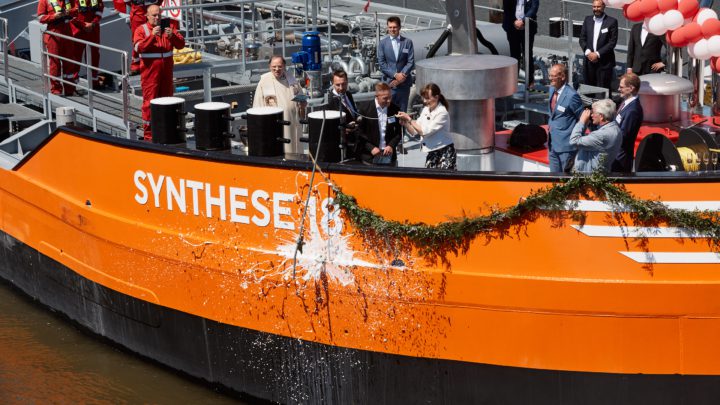
The innovative type C tanker was named ‘Synthese 18’ in the presence of invited guests at the Port of Rotterdam and then set off on its first official trip. It will be used on the river Rhine and its tributaries to transport liquid chemical products in future.
The newest member of the HGK Shipping fleet also combines a design that is optimised for shallow water operations with a diesel electric drive system.
“Thanks to our strategic programme for constructing new vessels, we’re laying the foundation for inland waterway shipping, which will meet the current and future requirements for sustainable and reliable transport operations. We’ll then manage to organise the transformation process towards providing decarbonised inland waterway shipping together with industry,” says Steffen Bauer, the CEO of HGK Shipping.
A real milestone in transporting liquid chemicals in European waterways
Norbert Meixner, the business unit director Liquid Chemicals at HGK Shipping, said: “The ‘Synthese 18’ marks a real milestone in transporting liquid chemicals on European waterways. It will enable us to maintain our role as a reliable partner for industry even during periods when water levels are low.”
HGK Shipping’s innovative shallow-water tanker is designed in such a way that it can still transport a load weighing 300 tonnes if the water is just 1.05 metres deep. The ‘Synthese 18‘ will therefore help ensure reliable supplies for the chemical industry in future, even if the water level on the river Rhine is critically low. The maximum payload capacity is 2,700 tonnes.
The shallow draught is made possible by the optimised uplift features of the vessel’s hull; this has been achieved by ingeniously arranging components such as the loading system and the drive technology. The vessel, which is 110 metres long and 11.45 metres wide, was deve-loped at HGK Shipping’s Design Center – just like all the more recent additions to the company’s fleet – and was designed in close cooperation with the transport management experts at Wijgula BV in Druten, which will operate the vessel with freight.
High tonnage level per trip
“Numerous practical optimisation measures have been included in the design of the ‘Synthese 18’. Our shipbuilding engineers cooperated closely with the turn-key shipyard from the very first ideas in 2020.
“Together, we’ve managed to significantly reduce the CO2 emissions per tonne kilometre even further. Although the shape of the bow and stern are unconventional – among other things, the vessel is equipped with a so-called bulbous bow – the intelligent power management system ensures that the power that is available (1,200 kW) is fed in and used in the best possible manner.
“The stainless-steel tanker demonstrates that a combination of sustainability and reliability of supplies doesn’t have to conflict with a high tonnage level per trip,” said Tim Gödde, business unit director ship management, HGK Shipping.